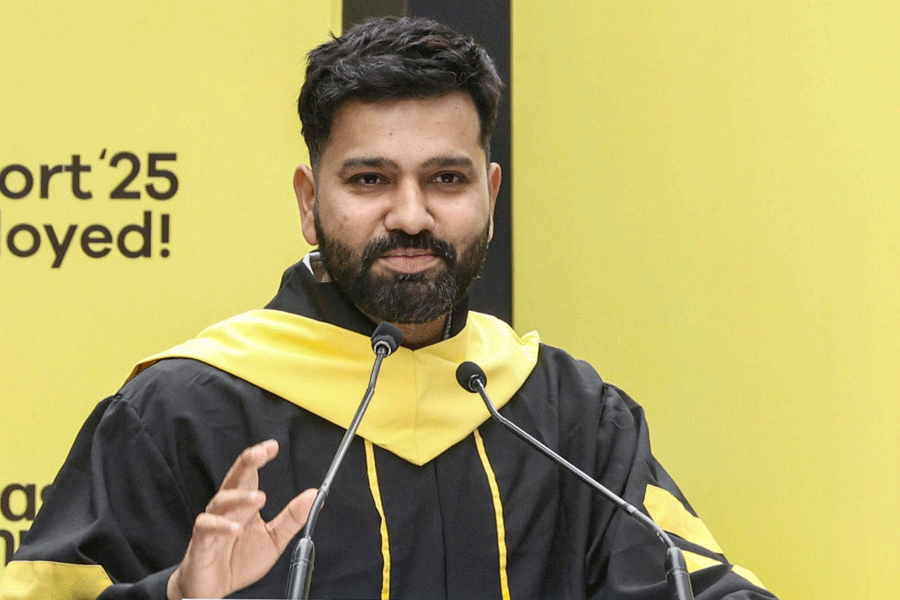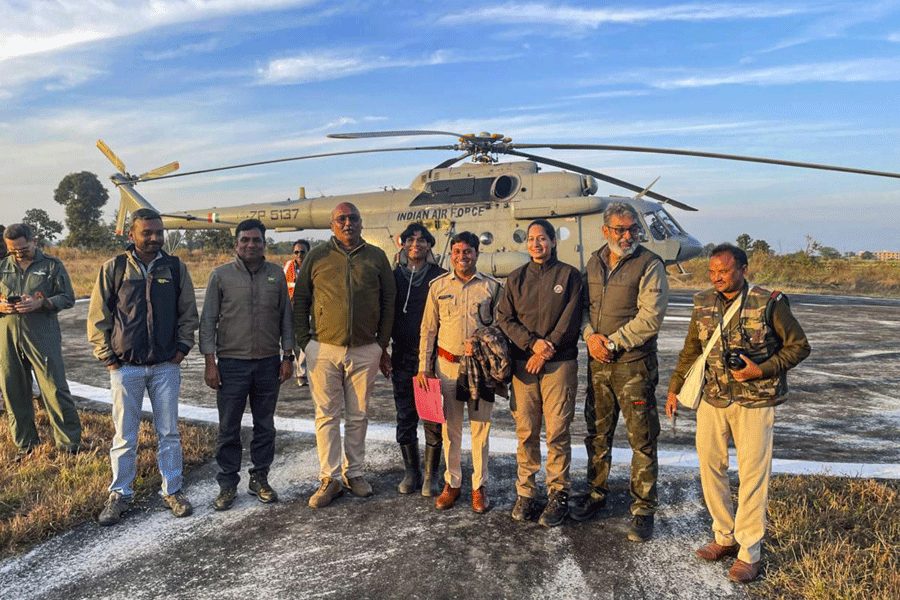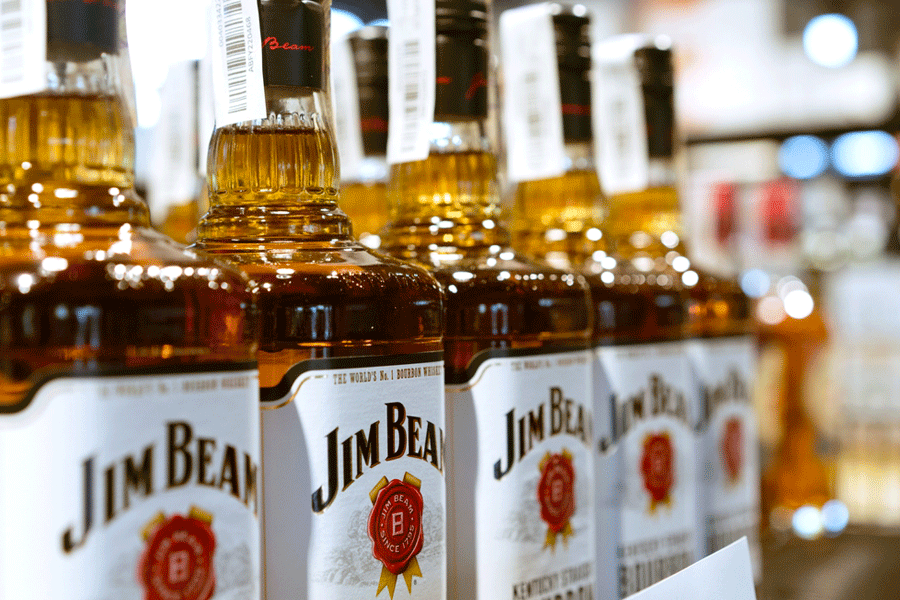Dhang family in Salkia
 |
Sriram Dhang left his ancestral home in Rajhati in Hooghly in 1937 to settle in Salkia, Howrah. He was the first to establish a cast iron factory in Howrah and built a house of his own on what is now known as Babudanga on Sriram Dhang Road. Since his ancestors were zamindars of Rajhati, Durga puja was a traditional affair in the family. Trying to keep the tradition alive, Dhang decided to organise Durga puja at his Salkia home in 1873. Most of the 130-odd members of the Dhang family still live at the Salkia residence and actively participate in Durga puja. The expenses of the puja are met from the Durga Mata O Lakshmi Mata Estate. The puja completed 140 years this year. After Bodhon on Sashthi and bathing of Kalabou on Saptami morning, a minimum of 21 Brahmins are treated on Saptami evening. “Earlier, they would have a full meal, but now most of them are busy and do not have the time to sit and eat. So we m
ake packets of luchi, torkari, fruits and sweets for them and distribute these on Saptami evening,” said Saikat Dhang, a member of the family. Dhuno porano is done twice, once on Ashtami morning and again at Sandhi puja. This year 16 women of the family took part in the ritual where they had to carry earthen pots of fire on their heads and both hands. After which, the men and boys who are younger in age or relation sit on the laps of the older women. “The eldest member of our family is Geetarani Dhang, my aunt (jethima) who is 86 years old. My uncle and father, both of who are above 70, took turns to sit on her lap,” said Saikat. Kumari puja is organised on Navami. After immersion of the idol on Dashami, the kathamo or wooden frame of the idol is brought back to the house and kept for the following year. “This has been the tradition since 1873 but with time, as parts of the frame has decayed, we have had to replace the wood,” said Saikat.
Kundu Chowdhury family in Andul
 |
This was the 293rd Durga puja at the Kundu Chowdhury house in Andul. The family is one of the few who organise Durga puja twice a year, once during Basanti puja in the month of Chaitra and again during Akal Bodon. Durga’s form is peaceful here. The goddess is worshipped along with Shiva as Hara-Gouri. “Since we are Vaishnav, we do not believe in showing Durga as violent or angry. The goddess is portrayed as blessing devotees, sitting along with Shiva on a white bull,” said Srikumar Kundu Chowdhury, a member of the family. This year, the goddess along with Lakshmi, Saraswati, Kartick and Ganesh have all got new gold-plated silver crowns. The expenses of the puja are met from the Mohiary Kundu Chowdhury Sri Sri Lakshmi Janardhan Jew Estate. Dhuno porano is also a ritual which is performed only by the older women of the family. The younger ones do not participate. “Most of them are still under training and some are afraid of carrying fire in their hands,” said Srikumar. This year 11 women of the family performed the ritual on Ashtami morning. Sindur daan on Dashami is strictly observed as a ritual in this family. “The women are not allowed to play with vermilion, they just put a little on each other after completing baran of the deity,” said Srikumar. After four days of vegetarian food, the family members are allowed to eat fish on Dashami, that too after the idol has been brought down from the mandap. “The women who actively take part in making the arrangements of the puja, specially those who cook the bhog, have to maintain a fast for four days. They cannot eat anything else other than fruits in the evening,” said Srikumar.
Ghosh family of Jagachha
 |
Ramchandra Ghosh started Durga puja about 150 years ago at what is now known as Jagachha. At that time he worshipped a clay Durga idol that was immersed after puja. Later, his son, Nibaran Ghosh established a permanent Shiva Durga temple near the house. The temple was established in 1324 of the Bengali calendar. As Nibaran Ghosh had three daughters, his estate went into his daughter’s family, Durgabala Pratihar and her husband. Other than Shivratri and other pujas that are observed at the temple, Durga puja is also performed here. All rituals of Durga puja are followed here as devotees gather at the temple to offer prayers. “Earlier, when Ramchandra Ghosh performed Durga puja, buffalo was sacrificed. Later, however, the ritual was stopped. Now we do not have any form of sacrifice at the temple,” said Goutam Pratihar, son of Durgabala. Due to internal family disputes, the puja has also become a small and uneventful affair. While fruits and sweets are offered in the morning, the evening luchi bhog goes missing.
Mitra family in Andul
 |
Since Jogendranath Mullick of Andul was childless, the property in Andul went to his brother’s daughter Giribala and her husband Mohini Mohan Mitra. Thus, the Mitras became the new zamindars of Andul. While Durga puja was a regular ritual at the Andul residence at one time, after the sudden death of Mohini Mohan, the puja was stopped. “Since Mohini Mohan and Giribala’s son, Rajendranath, was too young to perform the puja, it was not held that year. In fact, the Puja was not held for a number of years for various reasons. After a long gap of 150 years, we decided to revive Durga puja and this is the fourth running year that it is being held at this house,” said Debraj Mitra, a member of the family. A century and half down the line, the younger members of the family feel that Durga puja is a festival that brings the family together. “Most of us live separately and our children do not meet their cousins or other relatives often. At least during Durga puja they get to know each other,” said Debraj. As no one knows what rituals were followed 150 years ago, the family members have agreed to follow the timings and rituals of Ramakrishna Mission. On Ashtami this year, eight young girls between eight to 11 years were worshipped for Kumari puja. In the evenings, the elderly women of the family and locality sang devotional songs before the goddess.










